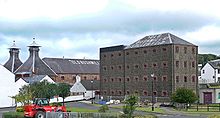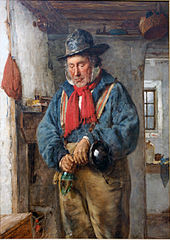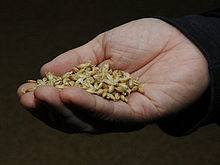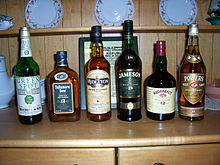
Whisky
About this schools Wikipedia selection
SOS Children made this Wikipedia selection alongside other schools resources. A quick link for child sponsorship is http://www.sponsor-a-child.org.uk/
Whisky or whiskey is a type of distilled alcoholic beverage made from fermented grain mash. Different grains are used for different varieties, including barley, malted barley, rye, malted rye, wheat, and corn. Whisky is typically aged in wooden casks, made generally of charred white oak.
Whisky is a strictly regulated spirit worldwide with many classes and types. The typical unifying characteristics of the different classes and types are the fermentation of grains, distillation, and aging in wooden barrels.
Etymology
The word whisky (or whiskey) is an anglicisation of the Gaelic word uisce|uisge meaning water. Distilled alcohol was known in Latin as aqua vitae = "water of life". This was translated to Gaelic as Irish: uisce beatha and Scottish Gaelic: uisge beatha = "lively water" or "water of life". Early forms of the word in English included uskebeaghe (1581), usquebaugh (1610), usquebath (1621), usquebae (1715).
History
It is possible that distillation was practised by the Babylonians in Mesopotamia in the 2nd millennium BC, with perfumes and aromatics being distilled but this is subject to uncertain and disputable interpretation of evidence. The earliest certain chemical distillations were by Greeks in Alexandria in about the 3rd century (AD), but these were not distillations of alcohol. The medieval Arabs adopted the distillation technique of the Alexandrian Greeks, and written records in Arabic begin in the 9th century, but again these were not distillations of alcohol. Distilling technology passed from the medieval Arabs to the medieval Latins, with the earliest records in Latin in the early 12th century. The earliest records of the distillation of alcohol are in Italy in the 13th century, where alcohol was distilled from wine. An early description of the technique was given by Ramon Llull (1232 – 1315). Its use spread through medieval monasteries, largely for medicinal purposes, such as the treatment of colic and smallpox.
The art of distillation spread to Ireland and Scotland by the 15th century, as did the common European practice of distilling ‘Aqua Vitae’ or spirit alcohol primarily for medicinal purposes. The practice of medicinal distillation eventually passed from a monastic setting to the secular via professional medical practitioners of the time, The Guild of Surgeon Barbers. In the Irish Annals of Clonmacnoise in 1405, the first written record of whisky attributes the death of a chieftain to "taking a surfeit of aqua vitae" at Christmas. In Scotland, the first evidence of whisky production comes from an entry in the Exchequer Rolls for 1494 where malt is sent "To Friar John Cor, by order of the king, to make aquavitae", enough to make about 500 bottles.
James IV of Scotland (r. 1488–1513) reportedly had a great liking for Scotch whisky, and in 1506 the town of Dundee purchased a large amount of whisky from the Guild of Surgeon Barbers, which held the monopoly on production at the time. Between 1536 and 1541, King Henry VIII of England dissolved the monasteries, sending their monks out into the general public. Whisky production moved out of a monastic setting and into personal homes and farms as newly independent monks needed to find a way to earn money for themselves.
The distillation process was still in its infancy; whisky itself was not allowed to age, and as a result tasted very raw and brutal compared to today’s versions. Renaissance-era whisky was also very potent and not diluted. Over time whisky evolved into a much smoother drink.
With a licence to distil Irish whiskey from 1608, the Old Bushmills Distillery in the north coast of Ireland is the oldest licenced whiskey distillery in the world.
In 1707, the Acts of Union merged England and Scotland, and thereafter taxes on it rose dramatically.
After the English Malt Tax of 1725, most of Scotland’s distillation was either shut down or forced underground. Scotch whisky was hidden under altars, in coffins, and in any available space to avoid the governmental Excisemen. Scottish distillers, operating out of homemade stills, took to distilling whisky at night when the darkness hid the smoke from the stills. For this reason, the drink became known as moonshine. At one point, it was estimated that over half of Scotland’s whisky output was illegal.
In America, whisky was used as currency during the American Revolution. It also was a highly coveted sundry and when an additional excise tax was levied against it, the Whiskey Rebellion erupted in 1791.
In 1823, the UK passed the Excise Act, legalizing the distillation (for a fee), and this put a practical end to the large-scale production of Scottish moonshine.
In 1831, Aeneas Coffey patented the Coffey still, allowing for cheaper and more efficient distillation of whisky. In 1850, Andrew Usher began producing a blended whisky that mixed traditional pot still whisky with that from the new Coffey still. The new distillation method was scoffed at by some Irish distillers, who clung to their traditional pot stills. Many Irish contended that the new product was, in fact, not whisky at all.
By the 1880s, the French brandy industry was devastated by the phylloxera pest that ruined much of the grape crop; as a result, whisky became the primary liquor in many markets.
During the Prohibition era in the United States lasting from 1920 to 1933, all alcohol sales were banned in the country. The federal government made an exemption for whisky prescribed by a doctor and sold through licensed pharmacies. During this time, the Walgreens pharmacy chain grew from 20 retail stores to almost 400.
Types
Whisky or whisky-like products are produced in most grain-growing areas. They differ in base product, alcoholic content, and quality.
- Malt whisky is made primarily from malted barley.
- Grain whisky is made from any type of grains.
Malts and grains are combined in various ways:
- Single malt whisky is whisky from a single distillery made from a mash that uses only one particular malted grain. Unless the whisky is described as single-cask, it contains whisky from many casks, and different years, so the blender can achieve a taste recognisable as typical of the distillery. In most cases, single malts bear the name of the distillery, with an age statement and perhaps some indication of some special treatments such as maturation in a port wine cask.
- Blended malt whisky is a mixture of single malt whiskies from different distilleries. If a whisky is labelled "pure malt" or just "malt" it is almost certain a blended malt whisky. This was formerly called a "vatted malt" whisky.
- Blended whiskies are typically made from a mixture of malt and grain whiskies — often along with neutral spirits, caramel, and flavouring. A whisky simply described as a Scotch, Irish, or Canadian whisky is most likely a blend. A blend typically contains whisky from many distilleries so that the blender can produce a flavour consistent with the brand. The brand name (e.g., Chivas Regal, Cutty Sark) usually does not, therefore, contain the name of a distillery. Jameson Irish Whiskey is an exception, as it comes from only one distillery.
In Canada, for the most part, each distillery makes all the components of its whiskies. Thus Canadian whiskies are best described as single distillery blends.
- Cask strength (also known as barrel-proof) whiskies are rare, and usually only the very best whiskies are bottled in this way. They are bottled from the cask undiluted or only lightly diluted.
- Single cask (also known as single-barrel) whiskies are usually bottled by specialist independent bottlers, such as Duncan Taylor, Gordon & MacPhail, and Kentucky Bourbon Distillers, amongst others. Each bottle of a single-barrel whisky is from an individual cask, and often the bottles are labelled with specific barrel and bottle numbers. The taste of these whiskies may vary substantially from cask to cask within a brand.
Whiskies do not mature in the bottle, only in the cask, so the "age" of a whisky is only the time between distillation and bottling. This reflects how much the cask has interacted with the whisky, changing its chemical makeup and taste. Whiskies that have been bottled for many years may have a rarity value, but are not "older" and not necessarily "better" than a more recent whisky that matured in wood for a similar time. After a decade or two, additional aging in a barrel does not necessarily improve a whisky.
Most whiskies are sold at or near an alcoholic strength of 40% abv, which is the statutory minimum in some countries – although the strength can vary, and cask-strength whisky may have as much as twice that alcohol percentage.
American whiskeys
American whiskey is distilled from a fermented mash of cereal grain. It must have the taste, aroma, and other characteristics commonly attributed to whiskey.
Some types of whiskey listed in the United States federal regulations are:
- Bourbon whiskey—made from mash that consists of at least 51% corn (maize)
- Corn whiskey—made from mash that consists of at least 80% corn
- Malt whiskey—made from mash that consists of at least 51% malted barley
- Rye whiskey—made from mash that consists of at least 51% rye
- Rye malt whiskey—made from mash that consists of at least 51% malted rye
- Wheat whiskey—made from mash that consists of at least 51% wheat
These types of American whiskey must be distilled to no more than 80% alcohol by volume, and any addition of colouring or flavouring is prohibited. These whiskeys must then be aged in new charred-oak containers, except for corn whiskey. Corn whiskey does not have to be aged but, if it is aged, it must be in un-charred oak barrels or in used barrels. Corn whiskey usually is aged briefly, typically six months.
If one of these whiskey types reaches two years aging or beyond, it is additionally designated as straight, e.g., straight rye whiskey. A whiskey that fulfils all above requirements but derives from less than 51% of any one specific grain can be called simply a straight whiskey without naming a grain.
U.S. regulations recognize other whiskey categories, including:
- Blended whisky—a mixture that contains straight whisky or a blend of straight whiskies and, separately or in combination, whiskey or neutral spirits, and may also contain flavourings and colourings
- Light whisky—produced in the U.S. at more than 80% alcohol by volume and stored in used or uncharred new oak containers
- Spirit whisky—a mixture of neutral spirits and at least 5% of certain stricter categories of whiskey
American blended whiskeys combine straight whiskey with neutral grain spirit (NGS), flavourings and colourings. The percentage of NGS must be disclosed on the label and may be as much at 80% on a proof gallon basis. Blended whiskey has the same alcohol content as straight whiskey but typically has a milder flavour.
Another important labelling in the marketplace is Tennessee whiskey, of which Jack Daniel's, George Dickel, Collier and McKeel, and Benjamin Prichard's are the only brands currently bottled. In practice, it is essentially identical to bourbon whiskey. Whiskey sold as "Tennessee whiskey" is defined as Bourbon under NAFTA and at least one other international trade agreement, and is similarly required to meet the legal definition of Bourbon under Canadian law.
Australian whiskies
Australian whiskies have won global whisky awards and medals, including the World Whiskies Awards and Jim Murray's Whisky Bible "Liquid Gold Awards".
Canadian whiskies
By Canadian law Canadian whiskies must be produced and aged in Canada, be distilled from a fermented mash of cereal grain, be aged in wood barrels with a capacity limit of 700 litres (185 US gal; 154 imp gal) for not less than three years, and "possess the aroma, taste and character generally attributed to Canadian whisky". The terms "Canadian Whisky", "Rye Whisky", and "Canadian Rye Whisky" are legally indistinguishable in Canada and do not require any specific grain in their production. Canadian whiskies may contain caramel and flavouring in addition to the distilled mash spirits, and there is no maximum limit on the alcohol level of the distillation. To be exported under one of the "Canadian Whisky" designations, a whisky cannot contain more than 9.09% imported spirits.
Danish whiskies
Denmark began producing whisky early in the 21st century. The first Danish single malt to go on sale was Lille Gadegård from Bornholm, in 2005. Lille Gadegård is a winery as well, and uses its own wine casks to mature whisky.
The second Danish distilled single malt whisky for sale was Edition No.1 from the Braunstein microbrewery and distillery. It was distilled in 2007, using water from the Greenlandic ice sheet, and entered the market in March 2010.
English whiskies
There are currently three distilleries producing English whisky. Though England is not very well known for making whisky there were distillers previously operating in London, Liverpool and Bristol until the late 19th century, after which production of English single malt whisky ceased until 2003.
Finnish whiskies
There are two working distilleries in Finland and a third one is under construction. Whisky retail sales in Finland are controlled solely by the state alcohol monopoly Alko and advertisement of strong alcoholic beverages is banned.
German whiskies
German whisky is a relatively recent phenomenon having only started in the last 30 years. The styles produced resemble those made in Ireland, Scotland and the United States: single malts, blends, and bourbon styles. There is no standard spelling of German whiskies with distilleries using both "whisky" and "whiskey". In 2008 there were 23 distilleries in Germany producing whisky.
Indian whiskies
The majority of Indian whiskies are blends with a small amount of grain whisky blended with neutral spirits distilled from fermented molasses, and as such could be considered a sort of rum.
Irish whiskeys
Irish whiskeys are normally distilled three times, Cooley Distillery being the exception as they also double distill. Though traditionally distilled using pot stills, the column still is now used to produce grain whiskey for blends. By law, Irish whiskey must be produced in Ireland and aged in wooden casks for a period of no less than three years, although in practice it is usually three or four times that period. Unpeated malt is almost always used, the main exception being Connemara Peated Malt whiskey.
There are several types of whiskey common to Ireland: single malt, single grain, blended whiskey and pure pot still whiskey.
Japanese whiskies
The model for Japanese whiskies is the single malt Scotch, although there are also examples of Japanese blended whiskies. The base is a mash of malted barley, dried in kilns fired with a little peat (although considerably less than in Scotland), and distilled using the pot still method. For some time exports of Japanese whisky suffered from the belief in the West that whisky made in the Scotch style, but not produced in Scotland, was inferior, and until fairly recently, the market for Japanese whiskies was almost entirely domestic. In recent years, Japanese whiskies have won prestigious international awards and now enjoy a reputation as a high quality product.
Scotch whiskies
Scotch whiskies are generally distilled twice, although some are distilled a third time and others even up to twenty times. Scotch Whisky Regulations require anything bearing the label "Scotch" to be distilled in Scotland and matured for a minimum of three years in oak casks, among other, more specific criteria. An age statement on the bottle, in the form of a number, must reflect the age of the youngest Scotch whisky used to produce that product. A whisky with an age statement is known as guaranteed age whisky. Scotch whisky without an age statement may, by law, be as young as three years old.
The basic types of Scotch are malt and grain, which are combined to create blends. Many, though not all, Scotch whiskies use peat smoke to treat their malt, giving Scotch its distinctive smoky flavour. Scotch malt whiskies are divided into five main regions: Highland, Lowland, Islay, Speyside and Campbeltown.
South African whiskies
Various varieties are produced and although still in its infancy South Africa have already earned a number of international awards for their fine whiskies.
Swedish whiskies
The first Swedish whisky to be produced was a blended whisky named Skeppets Whisky and was produced in Södertälje, Sweden between 1955 to 1970 by the Swedish alcohol monopoly Vin & Spritcentralen. As of October 2012 eight Swedish whisky distillers jointly started a trade organization called Svensk whiskyting. The active Swedish distilleries are (as of October 2012) Mackmyra Whisky, Ådalen Distillery, Gammelstilla whisky, Smögen whisky, Gotland whisky, Grythyttan whisky, Lappland Whisky, Hven whisky, Wannborga på Öland and Bergslagens Distillery.
Welsh whiskies
( Welsh: wysgi or wisgi) In 2000, Penderyn Distillery started production of Penderyn single malt whisky, the first Welsh whisky since all production ended in 1894. (Though a distillery operated near Brecon in the 1990s, making and selling "Prince of Wales" malt whisky.) The first bottles went on sale on 1 March 2004, Saint David's Day, and the whisky is now sold throughout the world.
Penderyn Distillery is located in the Brecon Beacons National Park and is considered to be the smallest distillery in the world.
Other whiskies
Manx Spirit from the Isle of Man is distilled elsewhere and re-distilled in the country of its nominal "origin". The Manx distillery takes a previously matured Scotch malt whisky and re-distills it.
In 2010 a Czech whisky was released, the 21-year-old "Hammer Head".
Recently at least two distilleries in the traditionally brandy-producing Caucasus region announced their plans to enter the Russian domestic market with whiskies. The Stavropol-based Praskoveysky distillery bases its product on Irish technology, while in Kizlyar, Dagestan's "Russian Whisky" announced a Scotch-inspired drink in single malt, blended and wheat varieties.
Names and spellings
Much is made of the word's two spellings: whisky and whiskey. There are two schools of thought on the issue. One is that the spelling difference is simply a matter of local language convention for the spelling of a word, indicating that the spelling varies depending on the background or personal preferences of the writer (like the difference between colour and colour; tire and tyre; or recognize and recognise), and the other is that the spelling should depend on the style or origin of the spirit being described. There is general agreement that when quoting the proper name printed on a label, the spelling on the label should not be altered. Some writers refer to "whisk(e)y" or "whisky/whiskey" to acknowledge the variation.
The spelling whisky (plural: whiskies) is generally used in Canada, Japan, Scotland, and Wales—while whiskey (plural: whiskeys) is more common in Ireland and the United States. The usage is not always consistent. For example, some prominent American brands, such as George Dickel, Maker's Mark, and Old Forester (all made by different companies), use the 'whisky' spelling on their labels, and the US legal Standards of Identity for Distilled Spirits document also uses the 'whisky' spelling.
"Scotch" is the internationally recognized term for " Scotch whisky". It is less used in Scotland, where the drink is called simply "whisky".
Chemistry
Whiskies and other distilled beverages, such as cognac, and rum are complex beverages that contain a vast range of flavouring compounds, of which some 200 to 300 are easily detected by chemical analysis. The flavouring chemicals include " carbonyl compounds, alcohols, carboxylic acids and their esters, nitrogen- and sulphur-containing compounds, tannins and other polyphenolic compounds, terpenes, and oxygen-containing heterocyclic compounds" and esters of fatty acids. The nitrogen compounds include pyridines, picolines and pyrazines.
Flavours from distillation
The flavouring of whisky is partially determined by the presence of congeners and fusel oils. Fusel oils are higher alcohols than ethanol, are mildly toxic, and have a strong, disagreeable smell and taste. An excess of fusel oils in whisky is considered a defect. A variety of methods are employed in the distillation process to remove unwanted fusel oils. Traditionally, American distillers focused on secondary filtration using charcoal, gravel, sand, or linen to remove undesired distillates.
Canadian distillers traditionally employ column stills, which can be controlled to produce an almost pure (and less flavourful) ethanol known as neutral grain spirit or grain neutral spirit (GNS). Flavour is restored by blending the neutral grain spirits with flavouring whiskies.
Acetals are rapidly formed in distillates and a great many are found in distilled beverages, the most prominent being acetaldehyde diethyl acetal (1,1-diethoxyethane). Among whiskies the highest levels are associated with malt whisky. This acetal is a principal flavour compound in sherry, and contributes fruitiness to the aroma.
The diketone diacetyl (2,3-butanedione) has a buttery aroma and is present in almost all distilled beverages. Whiskies and cognacs typically contain more of this than vodkas, but significantly less than rums or brandies.
Flavours from oak
Whisky that has been aged in oak barrels gets a number of components from the wood. One of these is cis-3-methyl-4-octanolide, known as the "whisky lactone" or "quercus lactone", a compound with a strong coconut aroma.
Commercially charred oaks are rich in phenolic compounds. One study identified 40 different phenolic compounds. The coumarin scopoletin is present in whisky, with the highest level reported in Bourbon whiskey.
Flavours and colouring from additives
Depending on the local regulations, additional flavourings and colouring compounds may be added to the whisky. Canadian whisky may contain caramel and flavouring in addition to the distilled mash spirits. Scotch whisky may contain added (E150A) caramel colouring, but no other additives. The addition of flavourings is not allowed in American "straight" whiskey, but is allowed in American blends.
Chill filtration
Whisky is often " chill filtered": chilled to precipitate out fatty acid esters and then filtered to remove them. Most whiskies are bottled this way, unless specified as unchillfiltered or non chill filtered. This is done primarily for cosmetic reasons. Unchillfiltered whiskeys often turn cloudy when stored at cool temperatures or when cool water is added to them, and this is perfectly normal.










